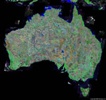 New Zealand melted before our very eyes at Wednesday night’s launch of Hot Topic, but serious flooding of the Minter Ellison boardroom was avoided, thanks to carefully planned adaptive strategies (and two large blue buckets). Scott Gallacher from Minter Ellison got things moving, followed by AUT vice chancellor Derek McCormack, who welcomed the arrival of AUT Media’s first book. I did my mini-Al Gore presentation – just the one slide, showing water plunging down a moulin in Greenland – and then David Cunliffe, who holds ministerial portfolios for Immigration, Communications, Information Technology and Associate Economic Development (standing in at short notice for David Parker, the climate change minister), made it clear to all that the government intended to take the issue very seriously. Then it was down to the real business of assessing the carbon neutral status of Grove Mill‘s products. A good night was had by all, including at least one freeloader, who has subsequently offered the contents of his/her “goody bag
New Zealand melted before our very eyes at Wednesday night’s launch of Hot Topic, but serious flooding of the Minter Ellison boardroom was avoided, thanks to carefully planned adaptive strategies (and two large blue buckets). Scott Gallacher from Minter Ellison got things moving, followed by AUT vice chancellor Derek McCormack, who welcomed the arrival of AUT Media’s first book. I did my mini-Al Gore presentation – just the one slide, showing water plunging down a moulin in Greenland – and then David Cunliffe, who holds ministerial portfolios for Immigration, Communications, Information Technology and Associate Economic Development (standing in at short notice for David Parker, the climate change minister), made it clear to all that the government intended to take the issue very seriously. Then it was down to the real business of assessing the carbon neutral status of Grove Mill‘s products. A good night was had by all, including at least one freeloader, who has subsequently offered the contents of his/her “goody bag
Tag: carbon
NZ’s low carbon cows: global warming heroes?
 A new report from Lincoln University´s Agribusiness and Economics Research Unit finds that New Zealand’s dairy industry has a smaller global warming footprint than the UK’s, even after taking into account the emissions resulting from shipping products half way round the world. From Lincoln’s press release:
A new report from Lincoln University´s Agribusiness and Economics Research Unit finds that New Zealand’s dairy industry has a smaller global warming footprint than the UK’s, even after taking into account the emissions resulting from shipping products half way round the world. From Lincoln’s press release:
The Lincoln study´s central finding is that the UK produces 35 percent more emissions per kilogram of milk solid than New Zealand and 31 percent more emissions per hectare than New Zealand – even including transportation from New Zealand to Britain and the carbon dioxide generated in that process.
The report’s lead author, professor Caroline Saunders, explains the importance of this finding:
“Our report clearly demonstrates the fallacy of using a simplistic concept like `food miles´ as a basis for restrictive trade and marketing policies. It is obvious that production systems and not transport are the major contributor to the differences in greenhouse gas emissions and energy use.
Fuel from willows
Interesting interview with Jim Watson, former President of the Royal Society of NZ on Kathryn Ryan’s Nine to Noon programme this morning (podcast here, but only for a week). Watson, the founder scientist of Genesis Research & Development discusses the new Biojoule project being established at Taupo. A species of willow (not the cricket bat kind) will be grown and harvested to produce ethanol as a biofuel, and lignin, a biological chemical alternative to hydrocarbons from fossil fuel as a feedstock for plastics. Home grown technology in every sense of the word.
Howard’s carbon conversion
 There’s an Australian federal election on the way, and – bless his cotton socks – John Howard has discovered there are votes in carbon policy. Over the last few days Howard has announced a national cap and trade programme for greenhouse gases as part of a new A$627 million climate change initiative, coupled with subsidies for solar hot water systems in schools, and an A$1,000 rebate for domestic installations. The carbon trading mechanism will not begin until 2011, covers only 55% of Australian emissions, and the administration has not announced how big the cap will be. Unsurprisingly, this has been criticised by environmental campaigners, as New Scientist reports:
There’s an Australian federal election on the way, and – bless his cotton socks – John Howard has discovered there are votes in carbon policy. Over the last few days Howard has announced a national cap and trade programme for greenhouse gases as part of a new A$627 million climate change initiative, coupled with subsidies for solar hot water systems in schools, and an A$1,000 rebate for domestic installations. The carbon trading mechanism will not begin until 2011, covers only 55% of Australian emissions, and the administration has not announced how big the cap will be. Unsurprisingly, this has been criticised by environmental campaigners, as New Scientist reports:
Caroline Fitzpatrick, of Greenpeace Australia accuses Howard of yielding to pressure from another group – Australia’s powerful coal industry – by announcing what amounts to a delaying tactic in carbon trading, rather than an effective new carbon-reduction scheme.
No doubt NZ’s Greenhouse Policy Coalition will renew its calls for the government on this side of the Tasman to match Howard’s cautious approach. Meanwhile, the Australia Institute has released a paper (press release, full paper [both PDF]), that calculates Australia’s emissions budget for the 21st century based on a “contract and converge
Kill possums and save the world
 Possums eat trees. Trees take carbon from the air. Kill possums, tree growth increases, and more carbon’s sucked out of the atmosphere. The Department of Conservation’s been keen on this idea for some time, to the extent of claiming last year that $200 million spent on possum and goat control would sequester enough carbon to meet New Zealand’s complete Kyoto emissions overshoot. They’ve finally convinced the cabinet that this is worth pursuing: conservation minister Chris Carter announced yesterday [Scoop, Stuff] that DoC will tender for commercial investment in six carbon offset trials.
Possums eat trees. Trees take carbon from the air. Kill possums, tree growth increases, and more carbon’s sucked out of the atmosphere. The Department of Conservation’s been keen on this idea for some time, to the extent of claiming last year that $200 million spent on possum and goat control would sequester enough carbon to meet New Zealand’s complete Kyoto emissions overshoot. They’ve finally convinced the cabinet that this is worth pursuing: conservation minister Chris Carter announced yesterday [Scoop, Stuff] that DoC will tender for commercial investment in six carbon offset trials.
Details of the projects are still being developed but they are likely to be of two types. The first will set aside specific areas of conservation land for either replanting or natural regeneration of forests on land which was not in forest prior to 1989, thus making these measures Kyoto compliant. The second type of project, likely to be the largest of the two, will involve major pest control initiatives on conservation land to measure and assess increases in carbon storage, both through the removal of pests which may emit methane and through increased growth in shrubs and trees with the pests gone.
Interestingly, Carter notes:
“Companies have already been approaching DOC with multi-million dollar conservation and carbon storage proposals. The government’s decisions mean that all New Zealand companies are put on a level playing field in a tender process for the carbon storage opportunities conservation land offers.
